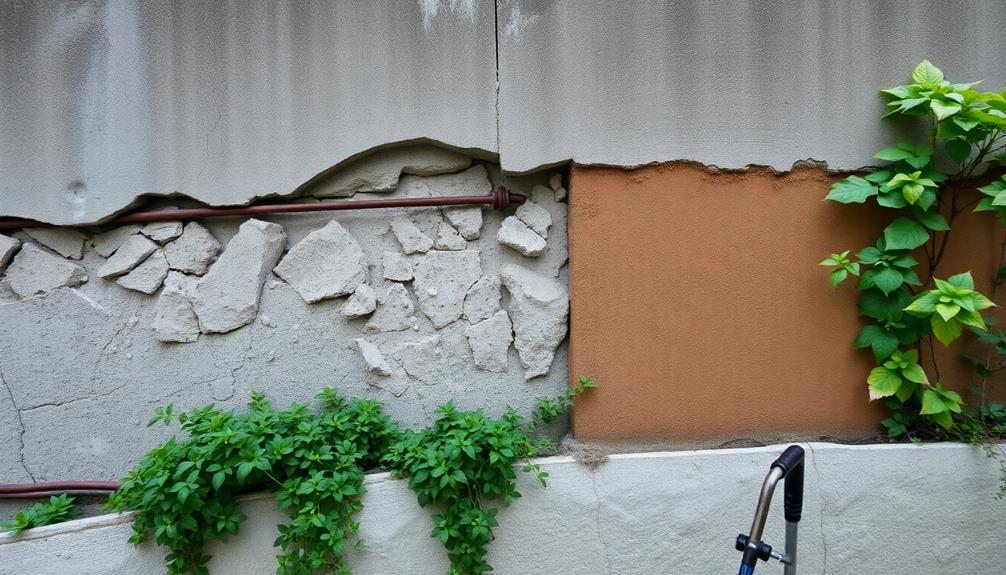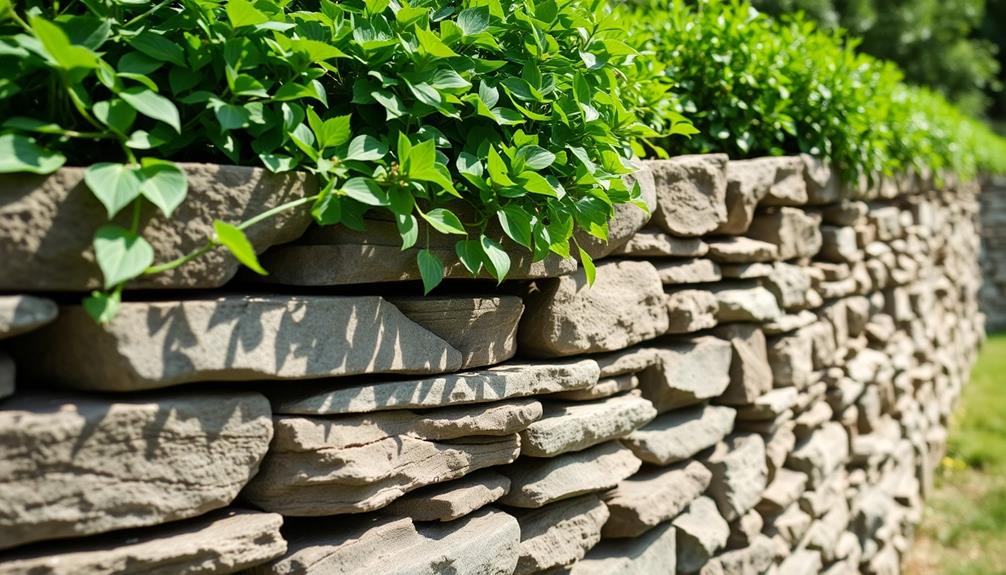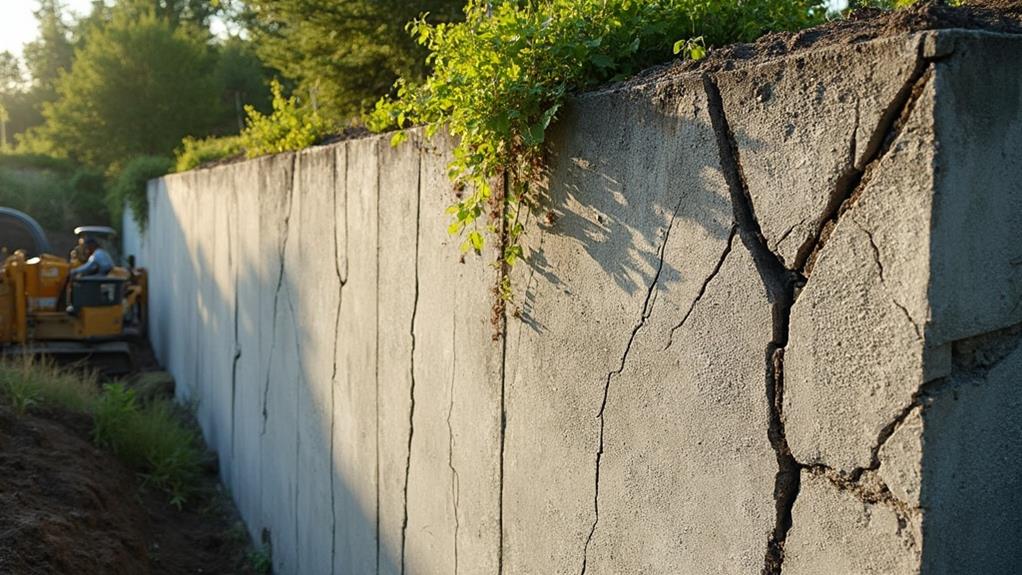Retaining wall repair techniques encompass a range of specialized methods designed to address structural damage, enhance stability, and extend the lifespan of these essential landscape features. Key approaches include patching and resurfacing, which involve surface preparation and application of advanced materials; crack injection techniques utilizing epoxy, polyurethane foam, or cement grout; and reinforcement installation methods such as soil nailing and tieback anchors. These strategies offer cost-effective, long-term solutions that improve structural integrity, reduce maintenance requirements, and increase property value. Additionally, soil reinforcement behind the wall through geosynthetic materials, soil nailing, and anchoring systems further enhances overall stability. Understanding the intricacies of these techniques can lead to more informed decisions about retaining wall maintenance and repair.
Table of Contents
ToggleWalls Contractor Highlights
- Patching and resurfacing repairs surface damage using specialized materials like epoxy compounds and polymer-modified cement.
- Crack injection techniques utilize epoxy, polyurethane foam, or cement grout to address various types of cracks.
- Reinforcement installation methods, including soil nailing and tieback anchors, improve load distribution and reduce failure risk.
- Geosynthetic reinforcement and soil nailing strengthen the soil mass behind retaining walls, enhancing overall stability.
- Professional assessment and application of repair techniques ensure long-lasting results and compliance with building codes.
Repair Methods for Deterioration

When addressing deterioration in retaining walls, several effective repair methods can be employed to restore structural integrity and extend the wall's lifespan. One of the key factors in successful repair is understanding the retaining wall materials being used, as different materials may require specialized approaches.
For example, patching and resurfacing techniques are commonly used to address surface-level damage, while crack injection procedures can effectively seal and stabilize deeper fissures within the wall's structure. Additionally, evaluating site conditions is vital for tailored solutions.
For more severe cases of deterioration, reinforcement installation methods, such as the addition of steel bars or anchors, may be necessary to provide enhanced support and prevent further structural compromise.
Patching and Resurfacing
For minor to moderate surface damage on retaining walls, patching and resurfacing techniques offer effective repair solutions. These methods involve applying specialized materials to restore the wall's structural integrity and aesthetic appeal. Skilled contractors utilize a range of products, including epoxy-based compounds, polymer-modified cement, and advanced concrete mixes, to address various types of deterioration.
The patching process typically begins with thorough surface preparation, including cleaning, removing loose debris, and creating a roughened surface for ideal adhesion. Contractors then apply the chosen patching material, carefully matching the texture and color of the existing wall.
For larger areas of damage, resurfacing may be necessary. This technique involves applying a thin layer of material over the entire surface, effectively creating a new, uniform appearance while addressing multiple areas of deterioration simultaneously.
To ensure long-lasting results, it is important to select appropriate materials based on factors such as the wall's composition, environmental conditions, and the extent of damage. Professional application techniques, including proper curing and sealing, are essential for maximizing the durability and effectiveness of patching and resurfacing repairs on retaining walls.
Crack Injection Techniques
Three primary crack injection techniques are commonly employed for repairing deteriorating retaining walls: epoxy injection, polyurethane foam injection, and cement grout injection. Each method offers unique advantages and is selected based on the specific characteristics of the wall's damage and environmental factors.
Epoxy injection, favored for its exceptional bonding strength, involves injecting a low-viscosity epoxy resin into cracks. This technique effectively seals hairline fractures and restores structural integrity. Polyurethane foam injection, on the other hand, is ideal for addressing water infiltration issues. The expanding foam fills voids and creates a watertight barrier, preventing further moisture-related deterioration.
Cement grout injection, utilizing a mixture of cement, water, and sometimes additives, is particularly effective for larger cracks and voids. This method not only fills the damaged areas but also reinforces the wall's overall structure.
The selection of the appropriate injection technique requires careful consideration of factors such as crack width, moisture presence, and the wall's load-bearing requirements. Professional assessment and application are essential to ensure the longevity and effectiveness of the repair, safeguarding the retaining wall against future deterioration and potential failure.
Reinforcement Installation Methods
As retaining walls face ongoing stress and environmental factors, reinforcement installation methods become essential for addressing structural deterioration. These techniques involve integrating additional support elements to enhance the wall's stability and load-bearing capacity. Engineers and contractors employ various reinforcement strategies, tailored to the specific needs of each retaining wall structure.
Three common reinforcement installation methods include:
- Soil nailing: Inserting steel bars into the soil behind the wall to create a reinforced soil mass
- Tieback anchors: Installing tensioned cables or rods deep into the soil to provide lateral support
- Geogrid reinforcement: Incorporating layers of high-strength polymer mesh within the backfill material
These methods substantially improve the wall's performance by distributing loads more effectively and reducing the risk of failure. When implementing reinforcement techniques, it is important to consider factors such as soil conditions, wall height, and existing structural integrity. Professional assessment and design are critical to ensure the chosen reinforcement method adequately addresses the wall's specific issues and meets local building codes and safety standards. By employing these advanced reinforcement strategies, property owners can extend the lifespan of their retaining walls and protect their investments.
Benefits

Implementing proper retaining wall repair techniques offers numerous advantages that extend beyond mere aesthetics. By using high-quality materials, such as boulders with unique appearances, repairs can also boost a property's curbside charm.
Cost-Effective Long-Term Solution
Investing in a cost-effective long-term solution for retaining wall repair offers numerous benefits for property owners. By addressing structural issues thoroughly, homeowners can avoid recurring problems and minimize future maintenance costs. A well-executed repair strategy not only restores the wall's integrity but also enhances its longevity, potentially adding decades to its lifespan.
Implementing durable solutions provides peace of mind and protects property value. Consider these key advantages:
- Reduced frequency of repairs, resulting in significant cost savings over time
- Enhanced structural stability, mitigating risks associated with wall failure
- Improved aesthetic appeal, contributing to overall property attractiveness
Professional repair techniques often incorporate advanced materials and methodologies that surpass the original construction standards. These improvements can include better drainage systems, reinforced anchoring, and superior soil stabilization measures. By investing in these enhancements, property owners not only resolve current issues but also fortify their retaining walls against future environmental stresses and potential ground movement. This proactive approach guarantees that the repaired structure will continue to perform its essential function of soil retention and erosion control for years to come, safeguarding both the property and its surroundings.
Improved Structural Integrity
Three key benefits of improved structural integrity in retaining wall repair include enhanced safety, increased longevity, and better performance under stress. When a retaining wall's structural integrity is bolstered, it drastically reduces the risk of collapse, guaranteeing the safety of nearby structures and individuals. This heightened stability provides property owners with peace of mind, knowing their investment is secure and compliant with local building codes.
Increased longevity is another pivotal advantage of improved structural integrity. By addressing underlying issues and reinforcing weak points, repaired retaining walls can withstand the test of time, requiring less frequent maintenance and reducing long-term costs. This durability is particularly beneficial for communities and homeowners associations seeking to maintain the aesthetic appeal and functionality of their shared spaces.
Furthermore, retaining walls with improved structural integrity demonstrate superior performance under various stressors, such as soil pressure, water accumulation, and seismic activity. This enhanced resilience ensures the wall continues to function effectively, preventing soil erosion and maintaining proper drainage. As a result, property owners can rely on their retaining walls to protect their landscapes and structures, fostering a sense of security and belonging within their community.
Enhanced Property Value
A property's value can substantially increase with the repair and enhancement of retaining walls. These structures not only provide vital support to landscaping and prevent soil erosion but also contribute immensely to the overall aesthetic appeal of a property.
When properly maintained and repaired, retaining walls can become striking features that elevate the entire landscape design, potentially leading to a noteworthy increase in property valuation.
Investing in retaining wall repairs and improvements can yield substantial returns for property owners:
- Enhanced curb appeal, creating a positive first impression for potential buyers or appraisers
- Increased usable outdoor space, expanding the functional square footage of the property
- Improved drainage and erosion control, mitigating potential long-term damage and maintenance costs
Reduced Maintenance Requirements
Properly repaired and well-maintained retaining walls greatly reduce ongoing maintenance requirements for property owners. By implementing effective repair techniques, homeowners can drastically decrease the frequency and intensity of future upkeep tasks. This reduction in maintenance not only saves time and effort but also contributes to a sense of community pride, as well-kept properties enhance the overall aesthetic appeal of neighborhoods.
The application of advanced repair methods, such as pressure grouting and soil nailing, reinforces the structural integrity of retaining walls, minimizing the need for frequent inspections and minor repairs. Additionally, the installation of proper drainage systems during the repair process mitigates water-related issues, which are often the primary cause of retaining wall deterioration. By addressing these fundamental concerns, property owners can expect extended periods between major maintenance interventions.
Furthermore, the use of high-quality, weather-resistant materials in the repair process guarantees longevity and durability. This approach not only reduces the likelihood of future damage but also diminishes the necessity for regular repainting or resurfacing. Ultimately, investing in professional retaining wall repair techniques translates to a more manageable, cost-effective property maintenance regimen that aligns with the collective interests of homeowners seeking to preserve the value and appearance of their communities.
Soil Reinforcement Behind Wall

Soil reinforcement behind retaining walls is essential for enhancing stability and longevity. Three primary methods—geosynthetic reinforcement, soil nailing, and anchoring systems—offer robust solutions for strengthening the soil mass. The following table outlines key characteristics of each technique:
| Method | Application | Main Advantage |
|---|---|---|
| Geosynthetic Reinforcement | Layered within backfill | Improves soil tensile strength |
| Soil Nailing | Drilled and grouted into soil | Provides internal stability |
| Anchoring Systems | Extends deep into stable soil | Increases overall wall capacity |
Geosynthetic Reinforcement Methods
Through the application of geosynthetic reinforcement methods, retaining walls can be greatly strengthened and stabilized. These techniques involve the integration of synthetic materials into the soil mass behind the wall, creating a composite structure that enhances overall stability and load-bearing capacity.
Geosynthetics, such as geotextiles, geogrids, and geocomposites, work by distributing forces more evenly throughout the soil, reducing lateral earth pressures on the wall face.
The implementation of geosynthetic reinforcement methods offers several key advantages:
- Increased wall height capacity without the need for excessive wall thickness
- Enhanced resistance to seismic forces and dynamic loads
- Improved drainage capabilities, reducing hydrostatic pressure buildup
When employing geosynthetic reinforcement, careful consideration must be given to the selection of appropriate materials based on site-specific conditions, soil properties, and design requirements. The installation process typically involves layering the chosen geosynthetic material at predetermined intervals within the backfill as it is placed and compacted. This systematic approach facilitates the integration of the reinforcement with the surrounding soil, creating a cohesive and resilient structure capable of withstanding significant loads and environmental stresses over extended periods.
Soil Nailing Techniques
A powerful method for reinforcing retaining walls, soil nailing techniques involve the insertion of reinforcing elements directly into the existing soil mass behind the wall. This process stabilizes the soil structure by creating a cohesive, reinforced soil mass that works in unison with the retaining wall. Soil nails, typically steel rods or bars, are drilled into the earth at a slight downward angle and grouted in place. These nails transfer tensile forces from the unstable soil mass to a more stable layer, effectively increasing the overall strength and stability of the retaining wall system.
The implementation of soil nailing techniques requires a detailed understanding of soil mechanics and structural engineering principles. Engineers must carefully analyze soil conditions, wall geometry, and loading factors to determine the suitable nail spacing, length, and orientation. This method offers several advantages, including minimal excavation requirements, reduced construction time, and cost-effectiveness compared to traditional retaining wall replacement. Additionally, soil nailing can be applied to existing walls, making it an excellent choice for repair and rehabilitation projects. By utilizing this technique, property owners can effectively extend the lifespan of their retaining walls while ensuring long-term stability and safety.
Anchoring Systems Implementation
Anchoring systems offer another effective approach to reinforcing retaining walls and stabilizing the soil behind them. This method involves installing tensioned cables or rods, known as anchors, into the soil mass behind the wall. These anchors are typically secured to a bearing plate on the wall face and extend deep into the stable soil or rock beyond the potential failure plane. By distributing the load over a larger area, anchoring systems greatly enhance the wall's stability and load-bearing capacity.
Implementing an anchoring system requires careful planning and execution:
- Site investigation and geotechnical analysis to determine soil conditions
- Design of anchor type, length, and spacing based on wall height and soil properties
- Installation using specialized drilling equipment and grouting techniques
For property owners and contractors alike, anchoring systems provide a reliable solution for addressing retaining wall instability. This technique is particularly effective for walls experiencing substantial lateral earth pressures or those constructed in challenging soil conditions. The implementation of anchoring systems not only extends the lifespan of existing structures but also improves the overall safety and integrity of the retaining wall, ensuring long-term stability for the surrounding landscape and infrastructure.
Walls Contractor FAQ
How Long Does a Typical Retaining Wall Repair Last?
The longevity of a retaining wall repair typically depends on various factors, including materials used, repair method, and environmental conditions. With proper maintenance, a well-executed repair can last anywhere from 10 to 30 years or more.
What Are Signs That Indicate a Retaining Wall Needs Repair?
Signs indicating a retaining wall needs repair include visible cracks, bulging or leaning, water seepage, soil erosion behind the wall, and separation from adjacent structures. Regular inspections can help us identify these issues early and maintain our community's safety.
Can Retaining Wall Repairs Be Done in Winter?
While retaining wall repairs can be conducted in winter, challenges may arise due to cold temperatures and frozen ground. Our team recommends scheduling repairs during milder seasons for best results and to guarantee the longevity of your retaining wall.
Are There Eco-Friendly Options for Retaining Wall Repair Materials?
Yes, eco-friendly options for retaining wall repairs are available. We can use recycled materials, sustainable aggregates, and plant-based geotextiles. These choices not only benefit the environment but also align with our community's values of responsible construction practices.
How Much Does Professional Retaining Wall Repair Typically Cost?
Professional retaining wall repair costs typically range from $1,000 to $10,000, depending on wall size, damage extent, and materials used. Our community of homeowners often finds that investing in quality repairs guarantees long-lasting stability and peace of mind.







